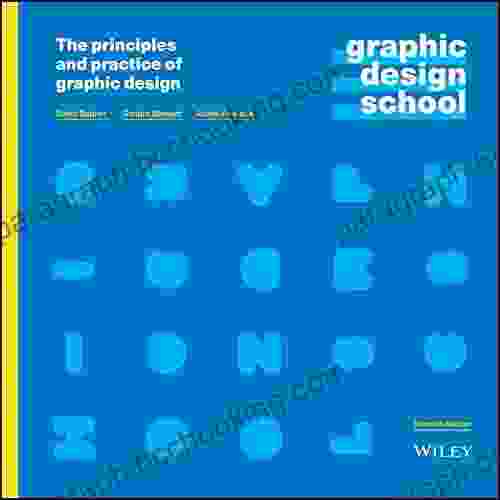Unlock the World of Visual Communication: Delve into "The Principles and Practice of Graphic Design"

In an era defined by the ubiquitous presence of visual imagery, graphic design has become an indispensable tool for effective communication. From captivating marketing materials to intuitive user interfaces, graphic design wields the power to engage audiences, convey messages, and drive action. "The Principles and Practice of Graphic Design" serves as an invaluable guide for aspiring and seasoned designers alike, offering a thorough exploration of the fundamental principles, essential techniques, and industry-leading practices that underpin this dynamic field.
This introductory chapter establishes a solid foundation for understanding the underlying principles that govern effective graphic design. Readers will delve into concepts such as:
Visual Hierarchy: Mastering the art of organizing elements within a design to guide the viewer's attention and create a logical flow of information.
Graphic Design School: The Principles and Practice of Graphic Designby Sandra Stewart4.4 out of 5
Language : English File size : 59690 KB Text-to-Speech : Enabled Screen Reader : Supported Enhanced typesetting : Enabled Print length : 206 pages Lending : Enabled Color Theory: Exploring the principles of color, including color psychology, color harmonies, and their impact on design aesthetics and communication.
Typography: Understanding the importance of selecting and using typefaces that complement the design concept, enhance readability, and convey the intended message.
Composition: Studying the techniques of arranging and combining design elements to create visually appealing and functional layouts.
Moving beyond theoretical foundations, Chapter 2 takes readers through the practical steps involved in executing successful graphic design projects. They will learn:
Project Planning: Establishing clear project goals, defining deliverables, and managing timelines to ensure project success.
Research and Analysis: Conducting thorough research to gather insights, identify target audiences, and inform design decisions.
Concept Development: Generating and developing creative concepts that align with project objectives and resonate with the intended audience.
Design Execution: Implementing design concepts using industry-standard software and techniques, including image editing, typography, and layout design.
Finalization and Delivery: Preparing and delivering final design files in various formats, adhering to industry standards and client specifications.
Typography plays a pivotal role in graphic design, shaping the visual appeal and readability of messages. Chapter 3 provides a comprehensive examination of typography, covering:
Font Selection: Exploring the vast array of typefaces available, understanding their characteristics, and choosing fonts that align with the design concept and communication goals.
Type Anatomy: Deconstructing the elements of typography, including typefaces, glyphs, kerning, and leading, to enhance design precision and legibility.
Type Composition: Mastering the principles of type composition to effectively combine typefaces, create visual hierarchy, and achieve desired aesthetic outcomes.
Typographic Trends: Examining contemporary trends in typography, including the use of variable fonts, web fonts, and experimental typography.
Images and colors have the capacity to evoke emotions, convey messages, and create memorable impressions. Chapter 4 explores the effective use of these elements in graphic design:
Image Selection and Editing: Understanding the principles of image selection, editing, and manipulation to enhance the visual impact of designs.
Color Psychology: Delving into the emotional and psychological effects of colors, enabling designers to make informed color choices that align with communication objectives.
Color Harmonies: Exploring color harmonies and their applications in graphic design, guiding designers in creating visually appealing and balanced color schemes.
Image Optimization: Learning techniques for optimizing images for digital and print media, ensuring high-quality reproduction and reducing file sizes.
In today's digital landscape, interface design has become increasingly important for creating user-friendly and engaging digital experiences. Chapter 5 covers:
UX Principles: Understanding the fundamental principles of user experience (UX) design, including user research, information architecture, and navigation design.
UI Elements: Exploring the essential UI elements, such as buttons, menus, and forms, and their role in creating intuitive and functional interfaces.
Accessibility: Ensuring that designs are accessible to all users, regardless of their abilities or disabilities, by adhering to accessibility guidelines.
Responsive Design: Mastering the techniques of responsive design to create interfaces that adapt seamlessly to different screen sizes and devices.
"The Principles and Practice of Graphic Design" culminates with a comprehensive summary of the key concepts and techniques covered throughout the book. Readers will gain a deeper appreciation for the power of graphic design as a tool for communication and problem-solving. The serves as a reminder of the continuous nature of learning in the field of design, encouraging readers to embrace ongoing exploration and experimentation to hone their skills and stay abreast of industry advancements.
- Interactive Exercises: Engaging exercises and activities integrated throughout the book to reinforce concepts and encourage practical application.
- Real-World Examples: Illustrative examples and case studies showcasing exceptional graphic design in various industries and contexts.
- Glossary of Terms: A comprehensive glossary providing clear definitions of key graphic design terminology.
- Online Companion Resources: Access to additional resources, including tutorials, templates, and design inspiration, to supplement the book's content.
4.4 out of 5
| Language | : | English |
| File size | : | 59690 KB |
| Text-to-Speech | : | Enabled |
| Screen Reader | : | Supported |
| Enhanced typesetting | : | Enabled |
| Print length | : | 206 pages |
| Lending | : | Enabled |
Do you want to contribute by writing guest posts on this blog?
Please contact us and send us a resume of previous articles that you have written.
 Book
Book Novel
Novel Page
Page Chapter
Chapter Text
Text Story
Story Genre
Genre Reader
Reader Library
Library Paperback
Paperback E-book
E-book Magazine
Magazine Newspaper
Newspaper Paragraph
Paragraph Sentence
Sentence Bookmark
Bookmark Shelf
Shelf Glossary
Glossary Bibliography
Bibliography Foreword
Foreword Preface
Preface Synopsis
Synopsis Annotation
Annotation Footnote
Footnote Manuscript
Manuscript Scroll
Scroll Codex
Codex Tome
Tome Bestseller
Bestseller Classics
Classics Library card
Library card Narrative
Narrative Biography
Biography Autobiography
Autobiography Memoir
Memoir Reference
Reference Encyclopedia
Encyclopedia Vahid Paeez
Vahid Paeez Thomas Golf
Thomas Golf Jon Gjengset
Jon Gjengset Philip A Moore
Philip A Moore Kellie Gerardi
Kellie Gerardi John Matthews
John Matthews Judi Whitton
Judi Whitton John Vornholt
John Vornholt John Warrillow
John Warrillow Joshua M Powell
Joshua M Powell Jone L Pearce
Jone L Pearce Johnnie Bachusky
Johnnie Bachusky Melissa Cleeman
Melissa Cleeman Joyceen S Boyle
Joyceen S Boyle Jonathan Wexler
Jonathan Wexler Joseph Frank
Joseph Frank Russell Maddicks
Russell Maddicks John Yates
John Yates John S Ahlquist
John S Ahlquist Joscha Remus
Joscha Remus
Light bulbAdvertise smarter! Our strategic ad space ensures maximum exposure. Reserve your spot today!
 Jay SimmonsFollow ·18.9k
Jay SimmonsFollow ·18.9k Vladimir NabokovFollow ·4.9k
Vladimir NabokovFollow ·4.9k Dennis HayesFollow ·15k
Dennis HayesFollow ·15k Tyrone PowellFollow ·13k
Tyrone PowellFollow ·13k Clay PowellFollow ·12.9k
Clay PowellFollow ·12.9k Vincent MitchellFollow ·11.9k
Vincent MitchellFollow ·11.9k Fernando PessoaFollow ·19.9k
Fernando PessoaFollow ·19.9k Esteban CoxFollow ·6.1k
Esteban CoxFollow ·6.1k

 Joseph Foster
Joseph FosterUnravel the Enigmatic Murders in "Pride and...
Dive into a World...

 Jeffery Bell
Jeffery BellTrauma-Focused CBT for Children and Adolescents: The...
Trauma is a...

 Jorge Luis Borges
Jorge Luis BorgesSense and Second Degree Murder: A Jane Austen Murder...
Prepare yourself for a...

 Chase Simmons
Chase SimmonsUnleash the Vibrant World of Watercolor: An Enchanting...
In the world of art, watercolor painting...

 Rubén Darío
Rubén DaríoAmerican Funny Animal Comics In The 20th Century: A...
Step into a bygone era of laughter and...
4.4 out of 5
| Language | : | English |
| File size | : | 59690 KB |
| Text-to-Speech | : | Enabled |
| Screen Reader | : | Supported |
| Enhanced typesetting | : | Enabled |
| Print length | : | 206 pages |
| Lending | : | Enabled |














